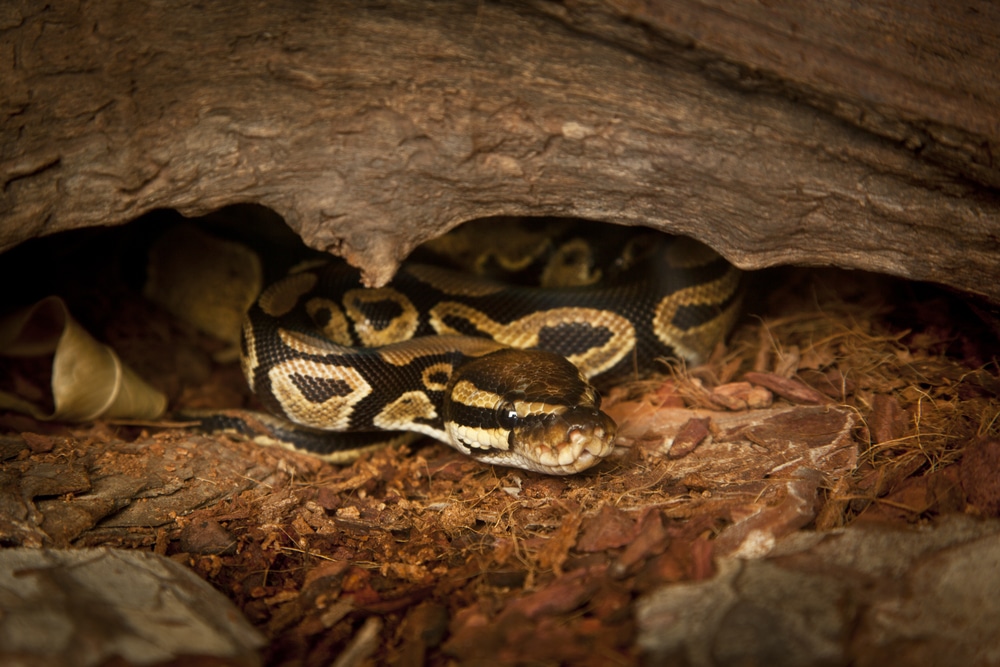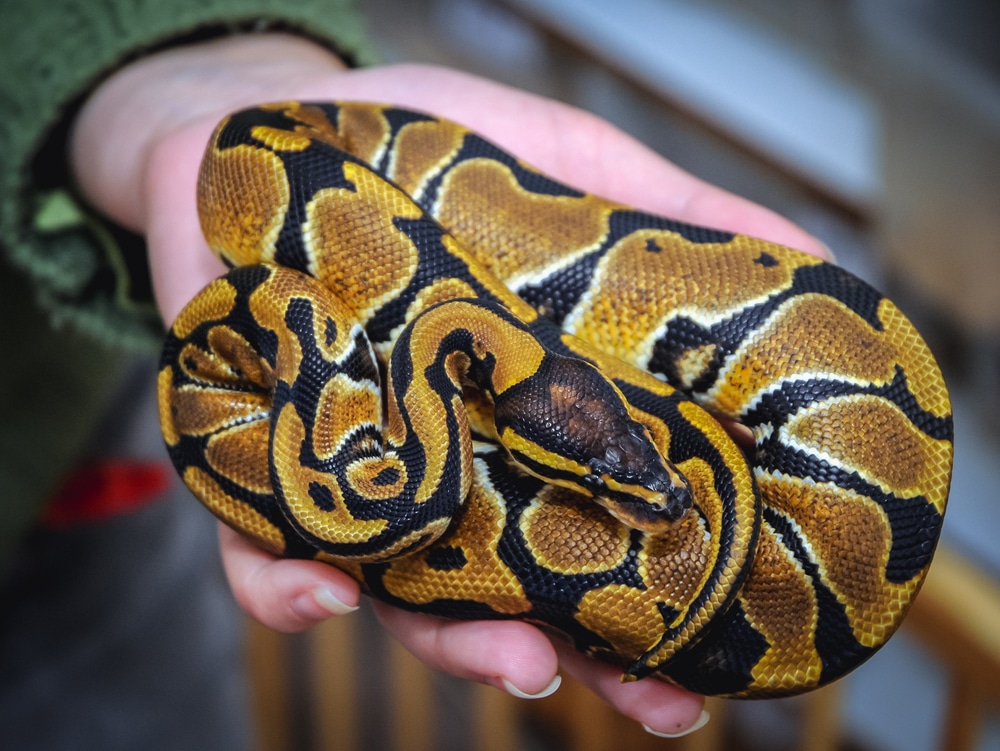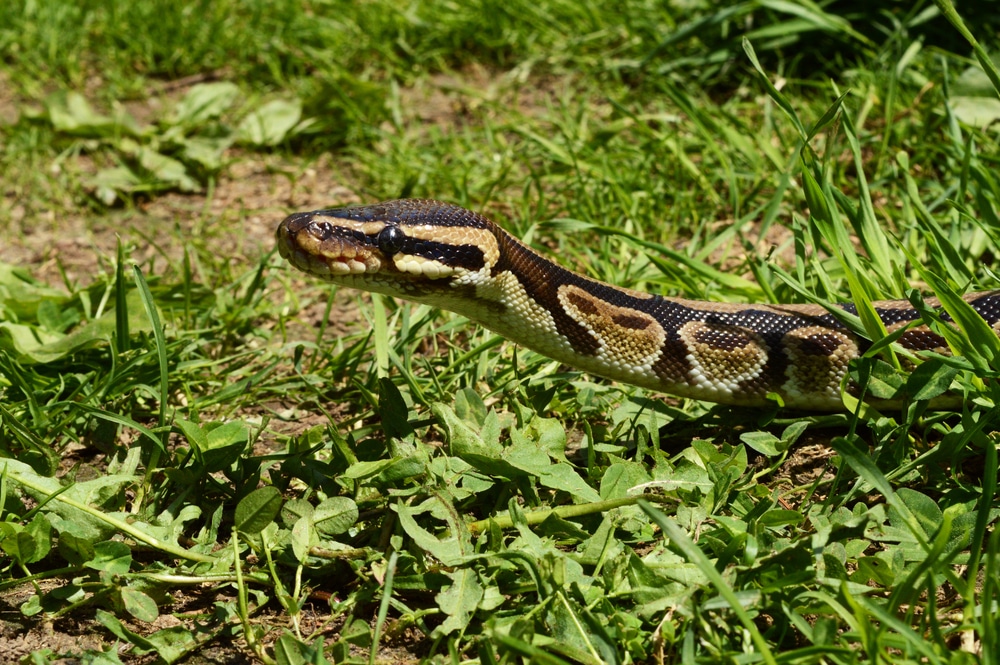Keeping a ball python as a pet is a multi-faceted endeavor. You’ll not only need to learn how to provide your pet with an appropriate enclosure and climate, but you must also learn how to interact with and handle the animal.
You also need to learn how to monitor your pet for signs of illness and familiarize yourself with the proper way to clean and maintain his habitat.

Fortunately, you can learn these types of things pretty easily. We’ve even covered things like feeding ball pythons before.
But there is at least one other aspect of ball python maintenance keepers must learn: How to provide a suitably rich and rewarding life for your pet. After all, you don’t want to go to all the trouble of keeping your pet alive, only to provide him with a horrible quality of life. And this means you want to enrich your pet’s life as much as possible.
We’ll discuss a few of the best enrichment ideas for your ball python below. You may not be interested in any of these strategies, and some of them may be unrealistic, given your situation. But it is also possible that our recommendations will spark some ideas you can implement.
Quick Navigation
What Do We Even Mean by Ball Python Enrichment Ideas?
Admittedly, the notion of enriching our ball pythons’ lives is a bit of a tricky subject. It’s not even clear that our efforts will provide any tangible benefit to our pets.
So, let’s start by taking a step back and consider some other animals.
All good dog owners, for example, will do things like visit the park or play fetch in the backyard to enrich their pet’s life. This helps keep the canines happy and generally provides a higher quality of life. It would be unthinkably cruel to force a dog to live in a small, non-stimulating environment for its entire life.
But dogs and snakes are very different animals – one has evolved alongside humans, while the other has primarily been viewed as a food source (until relatively recently, when we also began seeing them as pets). Dogs are also smart, social animals, who are hard-wired for interaction with other animals, while ball pythons are neither social nor do they appear especially intelligent.
We don’t know a lot about the inner workings of a ball python’s mind, but we can safely assume they don’t sit around all day pondering the mysteries of the universe. The bulk of their mental effort likely goes toward things like securing their basic needs and avoiding predators.
But there’s no reason to assume they can’t suffer, and it is wise to err on the side of caution when thinking about the quality of life we provide to our pets – no matter which branch of the tree of life they hail from.
So, some keepers strive to provide plenty of stimulation and novel experiences to their pet. It is possible – perhaps even likely – that most such stimulation is unnecessary, but as long as the stimulation and enrichment we provide don’t have any negative effects, there’s little harm in trying.
Worst case scenario? You go to a bit of effort that’ll ultimately fail to significantly improve your pet’s life.
But in a best-case scenario, you can help your snake avoid living a long, unfulfilling and boring life. And it won’t cost you a ton of time, money or effort to do so.

The Basics of Providing Enrichment Opportunities for Ball Pythons
It is important to employ enrichment ideas carefully for your ball python; you don’t want to make your pet sick or cause him stress while trying to improve his quality of life. That means keeping a few key points in mind:
- Don’t worry about enrichment strategies until you’re 100% sure you understand the basics of ball python care. Even though some of the recommendations that’ll follow seem simple, they increase the chances that something could go wrong. Experienced keepers may be able to spot the first warning signs of an impending problem and quickly shift gears; novice keepers are unlikely to be prepared to do so.
- Always be ready to halt your enrichment plans if your snake shows signs of significant stress or illness. As alluded to above, things may go wrong during your enrichment attempts. If this occurs, stop what you’re doing or restore typical conditions.
- Avoid implementing enrichment plans that may injure or sicken your snake. You must keep safety in mind while trying to enrich your snake’s life and try to foresee potential problems with your ideas. Will that branch shift and injure your snake? Will the heating pad get too hot if you set up the enclosure in a different way? Could that new substrate you intend to use cause your snake to choke?
- If you’re planning on implementing enrichment ideas, consider running them by a more experienced keeper first. Consulting more experienced keepers is always a good idea, and it is especially wise to do so when considering some of the unusual ways to enrich your pet’s life.
Above all else, remember that providing enrichment for your ball python is a bit of an experiment. Nobody has a great deal of experience with this concept, so you must be willing to learn and make adjustments as you go.

Seven Enrichment Ideas for Ball Pythons
Now, having explained what we mean by enrichment and reviewing a few important basics, we can begin diving into some of our enrichment ideas below. Just remember to be cautious when employing these plans and always keep your snake’s well-being at the forefront of your mind.
1. Set Up a Natural Vivaria Rather than a Utilitarian Habitat
Enclosure complexity exists along a spectrum. Keepers at one end typically prefer to provide simple, no-frills, utilitarian habitats for their snakes; keepers at the other end of the spectrum like re-creating natural habitats and incorporate things like live plants and bioactive vivarium substrates.
Neither approach is “right” or “wrong,” but most ball python keepers probably reside closer to the utilitarian end of the spectrum. Honestly, this makes a lot of sense, as simple enclosures are easier to maintain and provide less room for error. This can be especially helpful for novice keepers, who’re still learning the basics.
But there’s no reason keepers with sufficient experience can’t maintain ball pythons in more elaborate habitats. It will be more work and you’ll end up spending a bit more money to complete, but it is a viable approach. If nothing else, the complexity will provide interesting stimuli (including lots of unusual odors) to help keep your snake’s brain buzzing.
Just remember that you’ll need to replicate the ball python’s natural habitat pretty accurately. These animals hail from a variety of warm, humid environments, but they are not a rainforest species. They’ll likely fall ill if provided with a perpetually damp enclosure in captivity. So, strive to set up a forest- or grassland-like habitat, provide an appropriate thermal gradient, and keep the humidity high, but not too high.
2. Take Your Ball Python for a Backyard Stroll
It is generally unwise to remove your pet ball python from his habitat too frequently, and it is a bad idea to take him into public places, where he may make others frightened or uncomfortable. But there’s no reason you can’t take your pet out to explore your backyard from time to time. This will actually provide a lot of the same type of stimuli an elaborate habitat would.
Just be careful while doing so and keep common sense in mind. You don’t, for example, want to expose your snake to any pesticides, herbicides or fertilizers you’ve recently sprayed in your backyard.
Don’t wander away from your snake while he’s exploring – that’s a good way to lose him. Snakes are quite skilled at slipping into a hiding place quickly, and they’re often incredibly difficult to find once they’re out of sight. For that matter, you don’t want a hawk, feral cat or neighborhood dog to flex their predatory capabilities at your snake’s expense.
Make sure that you also keep the temperature in mind. You don’t want to take your snake out for a stroll on a crisp autumn morning, as the cool temperatures may cause him to fall ill. Doing so in the winter or early spring would simply be foolish. You’ll also want to be careful during the summer too, as excessive temperatures can quickly cause your snake to overheat.
But if the temperatures are in the 70s or 80s, and you have the time to monitor your pet, you may want to try letting him cruise around on the lawn for 10 minutes or so.
3. Turn Your Pet’s Habitat into a Multi-Level Enclosure
This one is a bit of a project, but it is one that is likely to provide good results. In fact, many experienced keepers incorporate multi-level housing concepts in their own collections.
The basic idea is to add a horizontal “floor” a few inches off the bottom of the enclosure. You’ll also need to add some supports and drill or cut a hole in the floor to provide the snake with an access route. Once installed, your snake has a “subterranean” section and a “surface” section to use as he wishes. It also effectively doubles the footprint of the enclosure, giving him more room to move and explore.
A multi-level enclosure can also provide interesting heating opportunities. It may, for example, enable you to provide a more exaggerated thermal gradient, by heating the surface layer and allowing the lower level to remain cooler than usual.
There is a down-side to multi-level enclosures, though: They’re more difficult to clean and maintain. It will also be more challenging to remove your snake quickly – you’ll usually have to commit to removing the second level to reach your pet.
4. Provide Climbing Opportunities for Your Pet
Ball pythons are usually considered pretty terrestrial animals, but they will climb from time to time if given the opportunity. So, in the interest of providing your snake with a fuller existence, you may want to experiment with climbing branches in your ball python’s enclosure.
Understand that while they will climb from time to time, ball pythons are not green tree pythons. They rarely spend all of their time climbing, and they often prefer different types of perches than their green cousins do. Whereas green tree pythons typically prefer a single, horizontal branch smaller than they are at mid-diameter, ball pythons often prefer branches that are larger than they are and feature plenty of sub-branches and crooks in which they can wedge their bodies.
You can use a variety of different types of branches. Most ball python keepers that provide their pet with climbing branches probably collect the branches themselves, but some keepers also purchase branches. Manzanita branches can be effective for young ball pythons, but grapevine is usually the better option for larger individuals.
- Perfect for basking
- Natural climbing environment
- Sandblasted clean
Always make sure that you brace climbing branches well or anchor them to the sides of the enclosure, to prevent your pet from falling. Also, don’t forget to clean your branches periodically, just like you would any other furniture in your pet’s habitat.
5. Re-arrange the Enclosure Furniture Periodically
One of the easiest ways to provide a small amount of mental stimulation for your pet is to move the items in his habitat around a bit. This obviously won’t provide stimulation over an extended period of time, as he’ll quickly adjust to the new layout, but you won’t need to spend a lot of time or money on this enrichment strategy. So, it’s often worth a try.
Just remember to keep the basic principles of habitat design in mind while rearranging the items in your pet’s habitat. You’ll still want to make sure that you provide a good thermal gradient, and that his water dish and hiding spaces are easy to access. Also, remember that – ideally – you’ll want to provide your snake with hiding opportunities on both the warm and cool side of the enclosure. This way, he doesn’t have to choose between his preferred temperature and security.
For extra points, purchase a few different versions of each piece of cage furniture you use. For example, instead of just buying a single piece of corkbark, buy three pieces in different shapes. You could do the same thing with water bowls and climbing branches, if you like.
- ✔️ Pest Free Cork Bark
- ✔️ Perfect for Reptiles, Orchids, Terrariums, and Airplants
- ✔️ May Include Rounds, Half Rounds, and Flats
You probably won’t want to include them all in the enclosure at the same time (unless it is quite large), but you can rotate them through the enclosure on a cycle. This also gives you the chance to sterilize the individual pieces that are not in use, so they’ll be ready to go back into the enclosure once it is their turn.
6. Take Your Snake for a Swim
Ball pythons aren’t aquatic, but like all snakes, they can swim. So, you may want to consider letting your snake swim on occasion. Swimming is a great form of exercise, and it’ll cause your pet’s brain to fire in ways it normally doesn’t.
It is important to note that some snakes (both at the individual and species level) “enjoy” time in the water more than others. Water snakes and anacondas cut through water without skipping a beat, but bull snakes will nearly levitate to get out of a puddle or pond as fast as possible.
Ball pythons usually fall somewhere in between these two extremes, so use your judgment – if your snake seems particularly displeased with the water, skip the swimming sessions. We’re trying to stimulate your snake’s brain in unusual – but not unpleasant – ways.
You’ll obviously need to keep safety in mind. Always be ready to lift your snake out of the water if he begins to struggle or tire, and make sure he has a branch available or can reach the side of the reservoir. Don’t let your snake swim in a chlorinated swimming pool – use a stock tank or kiddie wading pool filled with fresh water (tap water is fine).
Always use “room temperature” water when allowing a snake to swim. The water should feel the same temperature as the surrounding air does (and you should only allow your snake to swim when the ambient temperature is appropriate).
7. Allow Your Animal an Opportunity to Breed
Breeding snakes is not something that you should take lightly. Breeding trials can stress snakes in some cases, as can the cycling process used to prime the animals’ internal clocks. Complications can result in the death of either animal, although female snakes are certainly the more likely of the two to suffer such a fate.
And if you’re successful, you’ll wind up with a half-dozen or so hungry mouths to feed (in the case of ball pythons). You’ll also need to find homes for them in all likelihood – and this is not always an easy task. So, be sure to consider breeding carefully, as it is not a risk-free endeavor.
All that said, breeding provides a truly unique form of stimuli for your pet. It’s certainly possible that mating and the reproductive process is the most rewarding stimuli snakes typically experience. So, if you’re prepared to take the inherent risks and be responsible for the fruits of your labor, you may want to allow your snake to breed.
Just be sure that you educate yourself on the breeding habits of ball pythons and discuss the issue with your vet before deciding to get started.
Conclusion
Again, the concept of enriching your ball python’s life is a bit of a new thought process among snake keepers. So, you’ll want to be sure to proceed with care and be ready to make adjustments on the fly.
And just remember, while we may eventually learn that enriching your snake’s life is a worthless endeavor that they’ll never appreciate, this is a high-upside, low-downside venture. If you successfully enrich your snake’s life and he has the capacity to appreciate these changes, then you’ll “win.” But if we one day learn that there is no point in doing so, you haven’t lost anything in the process.
Let us know your ball python enrichment ideas in the comments below!
Last update on 2024-07-25 / Affiliate links / Images from Amazon Product Advertising API

